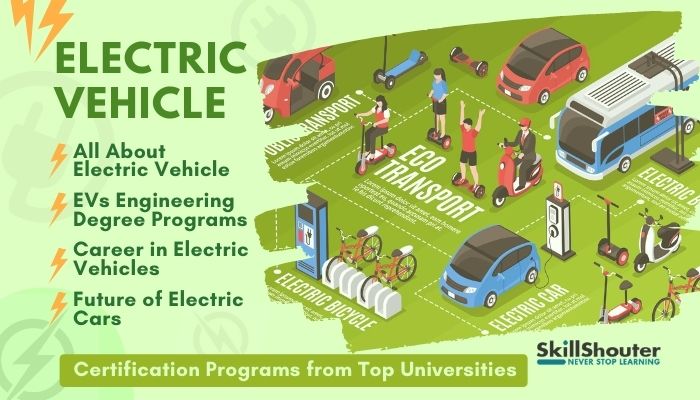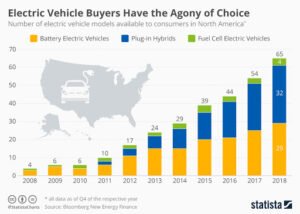This article will cover some major queries about Electric Vehicles, Types of electric vehicles, Best online college degrees, Electric vehicle engineering degree, Career (jobs) in electric vehicles, Future of electric cars, & the pros and cons of electric cars.
What is an electric vehicle?
As published in a noteworthy article, “The Future is Electric”. Electric vehicles derive most or all of the power from electricity. A major feature of the electric vehicle industry is the charging system. A user can connect the vehicle to an off-board power source. Hybrid Electric Vehicles however differ in this aspect. They substitute the combustion engine with a battery source but cannot be plugged-in to get charged.
The purchase of electric vehicles is not just a trending phase but a necessity. Joe Biden in a recent presidential debate had pledged to electrify possible modes of transport to reduce the strain on the consumption of oil. Traditional gasoline-powered vehicles alone take up 70% of America’s oil consumption as surveyed in 2019. In a research study conducted by the IVL, the estimate of CO2 emission per year was between 61kg and 106kg per kWh. This emission is in fact a great deal lower than gasoline-driven cars. The cost-effective aspect of electric vehicles is something to be taken note of. Consumers often wonder is it the best choice to shift to an electric vehicle.
Before taking up the numbers to satisfy the budgeting doubts, the various types of Electric Vehicles should be known.
Types of Electric Vehicles
The highest purchased varieties of electric vehicles are the All-Electric Vehicles(AEV), Plug-in Hybrid Electric Vehicles(PHEV). The AEVs can be further classified into Battery Electric Vehicles(BEV) and Fuel Cell Electric Vehicles(FCEV).
1. All Electric Vehicles (AEVs)
The AEVs draw their power completely from electricity. These types of vehicles are powered by 1 or more motors depending on the range desired. The consumption of natural resources i.e., gasoline is zero. The power acquired during the charging session is stored in batteries and later delivered to the motors.
Pros of Battery Electric Vehicles (BEV):
- Zero Petroleum-based fuel consumption.
- Zero exhaust emission.
- Minimal engine noise.
Cons of Battery Electric Vehicles (BEV):
- All-electric mechanism poses issues with covering long distances at a stretch before running out of battery.
- Common AEVs have a low range – 80 to 100 miles.
- Normal charging duration can take up to a day.
2. Plug-in Hybrid Electric Vehicles (PHEVs)
When range seems to be a problem, selecting PHEV is a wise choice. As the name suggests, it runs on a hybrid power source. Once the electric power source is depleted, it switches to an internal combustion engine that runs on gasoline.
This type of hybrid mechanism increases the range significantly. The fuel cost is also reduced considerably. PHEVs allow the consumer to frequently use both electricity to minimize fuel cost and petroleum fuel to cover long distances.
Pros of Plug-in Hybrid Electric Vehicles:
- Two modes of power supply. One acting as a backup to another.
- Can easily cover longer distances without charging or refueling.
Cons of Plug-in Hybrid Electric Vehicles: Costlier than AEVs
- Though less but visible tailpipe emissions
- Plug-in mode of easy charging is unavailable
3. Battery Electric Vehicles (BEVs)
Battery Electric Vehicles or BEVs are completely electric vehicles with rechargeable batteries. They draw power from high-capacity battery packs. This power source provides power to driving motors and remaining all electronic components in the car.
The rate of charging of the batteries can be classified into three levels:
Level 1 – Standard household dc chargers that supply a voltage of 120V. The charging duration is approximately 8 – 10 hours and can cover a range of 70 to 80 miles.
Level 2 – These chargers can supply a charging voltage of 240V. Generally found in workplaces and charging stations.
Level 3 – The fast chargers are found in dedicated Electric Vehicle charging stations. These can recharge your vehicle’s battery in 30 to 40 minutes.
Pros of Battery Electric Vehicles:
- Extremely eco-friendly.
- No combustion engine noise.
- Fast charging in level 3 reduces delay in the journey.
Cons of Battery Electric Vehicles:
- Significantly longer duration to charge in Level 1 chargers
- Reduction in the range covered based on charge.
- No backup power source.
Electric Vehicle Engineering Degree Programs
1. Automotive Engineering – Clemson University, South Carolina
Automotive Engineering is a branch of engineering catering to the field of vehicles. It cascades the elements of mechanical, electronic, and safety engineering. The motive of studying automotive engineering is to design, manufacture, test, and fabricate vehicles.
An aspiring engineer has the highest chance of displaying skills in this sector. This modern industry is a booming market for the engineers of this era. One of the best places to graduate with this degree in the USA is Clemson University. This M.S. course is apt for people with a passion for cars and a hunger for knowledge.
What You Learn:
- Designing of automobiles
- In-depth operation of combustion engines
- Production line technologies

2. Mechanical Engineering – Stanford University, California.
To earn a place in this automobile industry, having meticulous knowledge of the basics of vehicular functioning is a must. Mechanical Engineering is a broad-spectrum course in engineering that can cover aspects of power-producing machinery, internal combustion engines, turbines, etc.
Mechanical engineers are still hired by these industries because they have the knowledge to increase the efficiency of the production line as a whole. However, in the case of EVs, these engineers are highly paid. Students prefer to secure a degree from well-established universities like Stanford University.
What You Learn:
- Heat Transfer in vehicular engines
- Fluid Mechanics in Braking Systems
- Automatic Controls
Duration: 4 years





3. Electromechanical Engineering – Southern State Community College
As EVs are a combination of electronic circuit-based components and mechanical equipment, these engineers are highly demanded. Electromechanical engineering is a branch of engineering that refers to the “analysis, design, maintenance and manufacture” of electromechanical systems.
In terms of financial position, an electromechanical engineer in the US earns typically between $65683 and $ 76000. Such a promising career is sought after by students and professionals alike. Rather than physical classes which can be a bit taxing, online courses are preferred. The Southern State Community college provides this compact course for a duration of 2 years.
What You Learn:
-Hydraulics and Pneumatics
-Technical Mathematics
-AutoCAD and Engineering graphics





4. Hybrid Electric Vehicle (HEV) Curriculum – Michigan Tech (MTU), Houghton, Michigan.
The light vehicular industry has currently faced a crisis in the pool of quality engineers. This course is a continuation of professional engineers. Specifically targeted for the HEV EV industry, this course provides a vivid knowledge of the working and production of HEVs.
The flexible course at Michigan Tech covers more than 30 important courses. Students will have an option to opt for non-degree coursework, graduate certification, and a Master’s degree.
What You Learn:
- Electric Motors
- DC converters and inverters
- Power Management
Duration: 6 months – 18 months





Career (jobs) in Electric Vehicles
As you might have already guessed, this blooming industry is the Silver city for engineers and managers. The gradual shift of customers from traditional gasoline-powered cars to EVs also increases job vacancies. The main focus is generally on mechanical and automotive engineers. Mechanical engineering salary is widely varied for the position and type of work.
Several job profiles varying from mechanics to production manager can be applied for. Some of the job profiles in this field are listed below:
Mechanical Engineers – these people are responsible for manufacturing the chassis and body of the vehicle.
Electromechanical Engineers – they mainly focus on the internal connections of various components in the EVs.
Production Manager – Managers are always in demand for facilitating the smooth running of the unit.
Repair Mechanics – Maintenance of EVs is a must because of the absence of repair shops in the daily market.
It can be incurred that this industry is set only to grow with leaps and bounds in the years to come. Any job profile will be promising for the employee.
Future of Electric Cars
Fuel savings are not the only boon of these EVs. The maintenance cost over the years for these vehicles is way lower than traditional cars. It may seem that initial investment in EVs is higher. Although, repairing costs drop because of the smaller number of moving parts, smooth braking system, and absence of a large number of cooling fluids.
Accurate data can be taxing to take account of. However, New York City had reported in 2019, the average maintenance cost of an electric vehicle is between $200 to $400. On the contrary, this cost shoots up to more than $1600 in maintaining a standard gasoline-driven car.
In 2019, some of the best-selling EV models were Nissan Leaf, Tesla Model S and the Ford Fusion Energi. Tesla had sold over 154,840 Tesla Model 3 cars alone in 2019.The big shot companies in the field of electric vehicles are set to release modern Electric Vehicles in the years to come. Some of the upcoming models as marketed are:
Aspark Owl – This is one of the top-notch hypercar by the Japanese EV maker. It claims to produce 1984 horsepower from just 4 electric motors. The estimated cost is planned to be around $3.2 million.
BMW i4 – This EV will be inclined to a more conventional BMW design. The company has announced that the engines will produce 523 horsepower and will contain an 80kWh battery pack.
Bollinger B2 – This gladiator-style jeep will cost around $125,000. It has a unique design of tailgates both in the front and back. The high ground clearance of 20 inches and considerably high powered motors will allow it to carry 16-feet long lumber pieces with ease.
During the past decade, electric vehicle stocks have skyrocketed. It can be inferred that in the years to come there will be a major change of tide in the direction of EVs.


